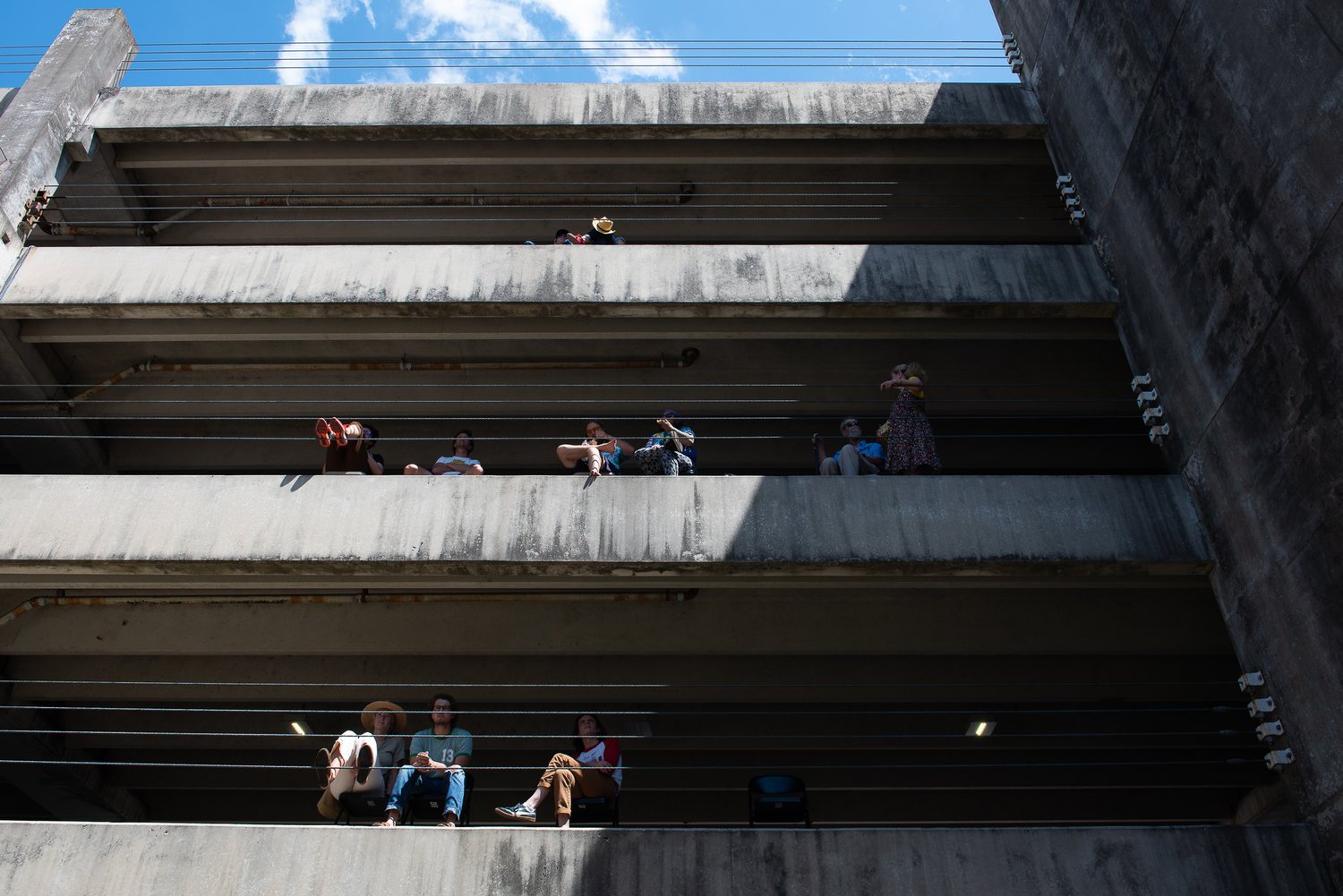
RAINFOREST REVERB
April 21, 2019 - State of Texas Capitol Complex, Garage B 1401 San Jacinto Blvd, Austin, TX
We teamed up with Fusebox Festival, for a 4-hour long sonic reinterpretations of an abstracted rainforest inside of a 5-story parking garage in downtown Austin, TX. We worked with 7 composers from all over the world to stage spatial compositions for a massive 32-channel audio system within the garage. Speakers were spread throughout each floor while the audience was free to roam to discover the sonic rainforest.
Composers:
Max Eilbacher (Baltimore), Joaquin Jimenez-Sauma (Mexico), Augusto Meijer (Netherlands), George Rahi (Canada) , Lyman Hardy (Austin) Adam Fangsrud / Sonya Gonzales (Austin)








Rolling Ryot’s Rainforest Reverb
by James Connolly
Activating all five levels of a parking garage in downtown Austin through a spatialized, 32-channel sound installation, Rainforest Reverb pushes the boundaries of immersive large-scale public sound art. The project is the most ambitious work of the Austinbased collective Rolling Ryot, who primarily focus on outdoor sonic installations inspired by the psychologically and perceptually disorienting acousmatic experiences of contemporary urban life. For Rainforest Reverb Rolling Ryot has commissioned artists from around the world to compose works that will be channeled through a complex arrangement of speakers to imitate the sonic structure of a rainforest. This will manifest as a concentration of lower frequency sounds toward the ground levels and higher frequency sounds toward the upper levels; a separation of sonic bandwidths that, as the artists describe, “imitates the evolutionary competition of animals for frequency spectrum inside a rainforest.” Speakers and subwoofers will be placed in a way that enables the sonic space of each floor to bleed up or down into the next. Four of the thirtytwo speakers will be moved throughout the space by performers on bicycles, expanding the aural experience while incorporating chance and randomness.
Rainforest Reverb extends a number of historical approaches to experimental multichannel sound productions. Its architectural spatialization is preceded by works like Edgard Varèse’s Electronic Poem (1958), which consisted of hundreds of speakers spread across a Le Corbusier structure at the 1958 Brussels World’s Fair. David Tudor’s Rainforest IV is also connected in both form and content. Developed from 1968-1973, Tudor’s project grew from a collaborative performative practice incorporating a range of sound-generating techniques including field recordings, mobile loudspeakers, and everyday objects that were repurposed into sculptural speakers emitting sounds formed to resonate their specific physical characteristics. Rainforest IV was a five-hour performance of these object-speakers installed throughout a barn for audience members to freely experience. Rolling Ryot's Rainforest Reverb takes a more contemporary form, using high-powered speakers driven by software with highly controllable spatialization tools to find resonance with the building itself.
Though the sounds of Rainforest Reverb are carefully composed and played back rather than performed in realtime, its large scale and open setting ensure that no spectator will have the same experience. As visitors wander through the labyrinth-like structure of ascending and descending ramps around a central atrium, reverberations of varying frequencies will shift dramatically depending on their location, mixing in with the spontaneous noise pollution of the city. Utilized because of its open and layered construction, the parking garage’s architecture is being exploited to separate frequencies and to render sonic definitions experienced both up close and from a distance, generating an environment capable of captivating visitors for long durations of time from a wide range of spatial positions.
The irony inherent in the project — conceptually emulating a rainforest in a parking garage, an icon of the urbanization that is undoubtedly contributing to the former’s demise — is not lost on the artists. The complexity and contradiction of Rainforest Reverb is intentional, and invites us to reflect on our inability to effectively fight the ongoing climate and environmental crises as consumers, producers, and citizens. The significance of this specific parking garage is most important because of its function and location. It is owned by the State of Texas and used for the Texas Capitol Complex, a space in which anti-environmental laws and policies have been passed for decades. But there are also more encouraging reasons this specific site was chosen: built in the 1970s, the garage contains an atrium that was designed to preserve two massive trees that were planted decades earlier. This enables the confrontation between the natural and constructed world in Rainforest Reverb to be experienced throughout its space, and alludes to a potentially less dystopian future that could be augmented by effective urban planning.
Rolling Ryot has confronted the ecological crisis in their previous work, including Extinction Project, in which they separated frog and bird frequencies from field recordings in quadraphonic compositions. Expanding upon the work of many other modern composers, they are drawn to the rainforest conceptually due to its acoustic complexity and its now fleeting existence. Rainforest Reverb is an immersive experience that captivates and enables the contemplation of the ecological moment we currently find ourselves in.
James Connolly is a Chicago-based artist, educator, writer, and curator. He teaches in the Film, Video, New Media, and Animation Department at the School of the Art Institute of Chicago and is the Assistant Curator of The Roger Brown Study Collection.


